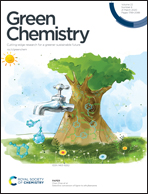Producing high yield of levoglucosan by pyrolyzing nonthermal plasma-pretreated cellulose†
Abstract
Atmospheric pressure nonthermal plasma treatment can be a novel, green and low energy method to convert biomass to biobased chemicals. The unique physiochemistry of plasma discharge enables reactions within biomass that otherwise could not possibly occur under traditional conditions. In this study, we present a simple method of producing a high yield of levoglucosan from cellulose without using any catalysts, chemicals, solvents or vacuum, but by using plasma treatment to control the depolymerization mechanism of cellulose. Cellulose was first pretreated in a dielectric barrier discharge reactor operating in ambient air or argon for 10–60 s, followed by pyrolysis at 350–450 °C to produce up to 78.6% of levoglucosan. Without the plasma pretreatment, the maximum yield of levoglucosan from cellulose pyrolysis was 58.2%. The results of this study showed that the plasma pretreatment led to homolytic cleavage of glycosidic bonds. The resulting free radicals were then trapped within the cellulose structure when the plasma discharge stopped, allowing subsequent pyrolysis of the plasma-pretreated cellulose to proceed through a radical-based mechanism. The present results also revealed that although the radical-based mechanism is highly selective to levoglucosan formation, this pathway is usually discouraged when the untreated cellulose is pyrolyzed due to the high energy barrier for homolytic cleavage. Initiating homolytic cleavage during the plasma pretreatment also helped the pretreated cellulose to produce higher yields of levoglucosan using lower pyrolysis temperatures. At 375 °C, the levoglucosan yield was only 53.2% for the untreated cellulose, whereas the yield reached 77.6% for the argon-plasma pretreated cellulose.



 Please wait while we load your content...
Please wait while we load your content...